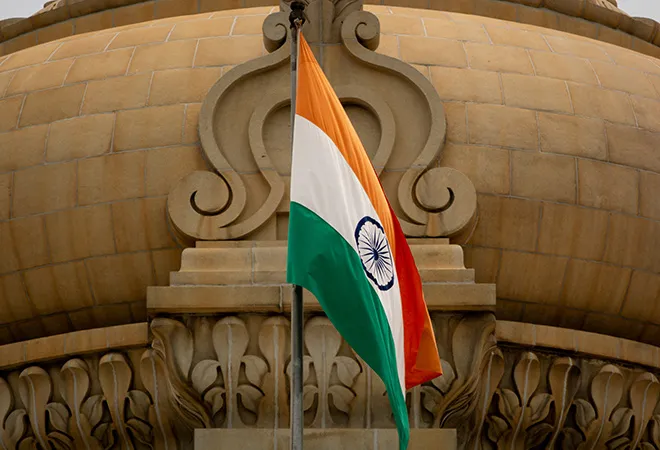-
CENTRES
Progammes & Centres
Location
Although Centre-state cooperation is crucial for Indian federalism, the competition amongst them cannot be discounted

Cooperation between Indian states and the Union government has been crucial in the implementation of various policies in the past, from the formation of the GST Council to the high-powered committee of chief ministers for a recommendation of reforms in Indian agricultural markets. The cooperative spirit in Indian federalism becomes even more relevant in the wake of the ongoing pandemic, where we have seen fluctuating political tensions between the Centre and states on issues ranging from the supply of oxygen cylinders to the availability of vaccines.
To be sure, the ripple effects of how the combination of Central and state policies have played out during the pandemic will not only have an immediate impact on the United Nations Sustainable Development Goals (SDG) agenda for 2030 such as SDG 3 (Good Health and Well-being), SDG 8 (Decent Work and Economic Growth) and SDG 10 (Reduced Inequalities), amongst others but also on the holistic resilience developed by the Indian states towards exogenous shocks such as the pandemic and its macroeconomic implications.
The cooperative spirit in Indian federalism becomes even more relevant in the wake of the ongoing pandemic, where we have seen fluctuating political tensions between the Centre and states on issues ranging from the supply of oxygen cylinders to the availability of vaccines.
To this effect, a recent report by ORF titled ‘Health Systems Resilience Index: A Sub-National Analysis of India’s COVID-19 Response,’ highlights the performance of states and Union Territories (UTs) in conjunction with the prescriptive role of central policies to mitigate the global crisis. The Health Systems Resilience Index (HSRI) was developed using 33 component indicators utilising data from government sources—both dynamic and static and classified into five broad sub-indices: General Health Profile; Medical Infrastructure; Technology Infrastructure; Institutional Support; and COVID-19-related Health Outcomes—to establish a granular analysis of India’s sub-national performance.
Table 1: HSRI – A Report Card
 Source: ‘Health Systems Resilience Index: A Sub-National Analysis of India’s COVID-19 Response,’ ORF
Source: ‘Health Systems Resilience Index: A Sub-National Analysis of India’s COVID-19 Response,’ ORF
India has had its fair share of ups and downs in the last two years whilst dealing with the pandemic. Despite its successes on some fronts, there is a need to invest more in the country’s health systems and at the same time leverage the strengths of the medical industry in the nation. Apart from providing a snapshot of India’s sub-national performance, the analysis also delves into other dimensions to aid policymaking.
Firstly, the UTs have exhibited significantly higher performance in health systems’ resilience in comparison to the states, highlighting which governance patterns are to be adopted for better outcomes. Secondly, the report also finds that states and UTs with higher per-capita income are significantly more resilient to these health emergencies than poorer regions which provide lessons on the complementarities between larger resource endowments and the required institutional support to mobilise them. Thirdly, the state-wise scorecards essentially imply which policies have worked and which have not, guiding the optimal reallocation of resources required across the Indian regions. Fourthly, the lacunae in some regions enable the country as a whole to work on its weaknesses to combat future medical exigencies such as the current Monkeypox disease. Finally, the study also expands the scope for spatial and longitudinal studies in this domain, which highlight the importance of evidence-based response for adaptive governance.
The lacunae in some regions enable the country as a whole to work on its weaknesses to combat future medical exigencies such as the current Monkeypox disease.
With the advent of the COVID-19 pandemic, India exercised a strong central leadership initially, to deal with the sudden obstacles the pandemic caused. At the same time, however, the role of the state and local governments, with different opinions and strategies to handle the crisis remained important too, putting India’s ‘cooperative federalism’ to test. Needless to say, coordination between the states and the Centre had its share of issues ranging from the first nationwide lockdown causing challenges for the migrant workers to the skirmishes regarding COVID-19 reporting across the country. Given the country’s geographical size, huge population, and multidimensional diversity, many issues came to the forefront; however, an excellent level of horizontal and vertical coordination between the states and the Centre is a testimony to India’s successful phased vaccination drives.
Although Centre-state cooperation is crucial for the functioning of India’s federal setup, the competition amongst them cannot be discounted. In fact, NITI Aayog’s ‘competitive federalism’ agenda is a natural progression over ‘cooperative federalism’ and both should ideally work in political synchronisation to drive India’s growth story in the coming years, from evolving governance patterns to domestic resilience in both health and economic systems. A renewed sense of competition amongst the sub-national economies is often looked upon as a method to enhance efficiency, allow for greater accountability and independence, and induce corrective actions in the state policies. But the question remains as to how ‘cooperative federalism’ and ‘competitive federalism’ will function as complementary ideas without showing traits of a ‘conflictual federalism’ time and again.
The views expressed above belong to the author(s). ORF research and analyses now available on Telegram! Click here to access our curated content — blogs, longforms and interviews.

Soumya Bhowmick is a Fellow and Lead, World Economies and Sustainability at the Centre for New Economic Diplomacy (CNED) at Observer Research Foundation (ORF). He ...
Read More +